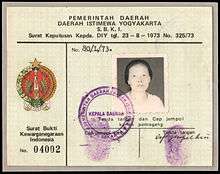Proof of Citizenship of the Republic of Indonesia


Proof of Citizenship of the Republic of Indonesia (Indonesian: Surat Bukti Kewarganegaraan Republik Indonesia abbreviated SBKRI) was an identity card establishing citizenship in the Republic of Indonesia employed to discriminate against Indonesians of Chinese descent. The card was a required identity card (KTP) to enter academia, obtain a passport, to register for an election, and to get married. The requirement was eventually abolished although local bureaucracies have continued to engage in abuses.
The legal bases for SBKRI legal was established with the Law no. 62 in 1958 issued by the Ministry of Justice G.A. Maengkom and approved by President Soekarno. It came in the wake of Mao Zedong's government decree in Communist China that all Chinese people around the world are citizens of the People's Republic of China based on the principle of jus sanguinis (blood descendants). This was followed with the Dual Citizen Agreement between Indonesia and China between Chou En-lai and Soenario in 1955.
Reform
On July 8, 1996, President Suharto issued Presidential Decree (Decree) No. 56 of 1996 on Proof of Indonesian Citizenship.
Chapter 4, point 2, reads, "For the citizens of the Republic of Indonesia, which has had a national identity card (KTP), or Family Card (KK), or a birth certificate, the fulfillment of the requirements for the particular interests simply use the Identity Card, or Card Family (KK), or the Birth Certificate. "
While Article 5 reads, "With the enactment of this Presidential Decree, all legislation that for certain interests require SBKRI, is no longer valid."
At 1999, issued Presidential Instruction No. 4/1999 on the Implementation of Presidential Decree No. 56/1996 which instructs invalidates SBKRI for ethnic Chinese who has become a citizen.
But in fact, the practice of SBKRI requirements still exist in the government bureaucracy because of the lack of socialization of the implementation of this decree, and also because of the weakness of the Indonesian legal system that led to the legislation can not simply be ignored.
Timeline
1946 - Indonesian legislation establishes that Indonesia adheres to the principle of jus soli and anyone who was born in Indonesia is an Indonesian citizen. The Chinese people in Indonesia since the Proclamation of 1945 were considered ethnic Chinese Indonesians.
1949 - The Chinese in Indonesia were required to choose whether they want to be a citizen.
1955 - Treaty Dual Nationality between China and Indonesia signed. Because there is a claim of Mao Zedong that China adheres to the principle of jus sanguinis, who was born to bring the clan of Chinese (offspring of male Chinese) then he automatically becomes a citizen of China. (This is a political reason for the support of overseas Chinese circles as done by ROC Taiwan (nationalist)). The KAA Bandung, Zhou Enlai stated that ethnic Chinese in Indonesia owes allegiance to the ancestral state.
1958 - Agreement set forth in the Act, confirms that the Chinese in Indonesia again be allowed to choose the nationality of China or Indonesia. Deadline until the elections in 1962. They must choose allegiance and maintain a single citizenship.
1969 - Treaty Dual Nationality canceled. Those with Dual Nationality become stateless.
1978 - Regulation of the Minister of Justice require SBKRI for Chinese citizens.
1983 - Decree of the Minister of Justice, confirmed that SBKRI only mandatory for those who took the affidavit Dual Nationality and expressed the desire to become citizen. So for a single citizen and his descendants (who has claimed to be the single citizen before 1962 and their descendants, as well as all those who were born after 1962) are not required SBKRI.
1992 - Decree of the Minister of Justice, confirmed that the descendants of the Chinese anak2 holder SBKRI SBKRI enough to include parents as proof they are a citizen.
1996 - Inclusion SBKRI no longer apply to the Decision of the President. But not many know because of lack of socialization.
Reform era 1999 - The Presidential Decree of 1996 was reinforced once again by Presidential Decree 1999.